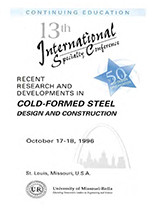Session Dates
17 Oct 1996
Abstract
The use of cold-formed steel members in building construction began in about the 1850's in the United States and Great Britain. However, such thin-walled steel members were not widely used for buildings until after 1946 When the first edition of the Specification for the Design of Light Gage Steel Structural Members was published by the American Iron and Steel Institute (AISI, 1946). This first design standard was based primarily on the research work sponsored by the Institute at Cornell University under the direction of Professor George Winter after 1939 (Winter, 1959a and 1959b). It was revised subsequently by the AISI Committees in 1956, 1960, 1962, 1968, 1980, and 1986 to reflect the technical developments and the results of continuing research (Yu, 1991). All the above mentioned seven editions of the AISI Specification adopted the conventional, allowable stress design (ASD) method. In 1991, AISI published the first edition of the Load and Resistance Factor Design Specification for Cold-Formed Steel Structural Members (AISI, 1991). Both AISI allowable stress design (ASD) and load and resistance factor design (LRFD) Specifications were combined into a single document in 1996 (AISI, 1996). The purpose of this paper is to summarize the historical developments of the AISI Specification during the past 50 years. A review of the past experience and background information will undoubtedly benefit the planning of future research and the development of new design criteria for cold-formed steel structural members and structural systems.
Department(s)
Civil, Architectural and Environmental Engineering
Research Center/Lab(s)
Wei-Wen Yu Center for Cold-Formed Steel Structures
Meeting Name
13th International Specialty Conference on Cold-Formed Steel Structures
Publisher
University of Missouri--Rolla
Document Version
Final Version
Rights
© 1996 University of Missouri--Rolla, All rights reserved.
Document Type
Article - Conference proceedings
File Type
text
Language
English
Recommended Citation
Yu, Wei-Wen; Wolford, Don S.; and Johnson, Albert L., "Golden Anniversary of the AISI Specification" (1996). CCFSS Proceedings of International Specialty Conference on Cold-Formed Steel Structures (1971 - 2018). 2.
https://scholarsmine.mst.edu/isccss/13iccfss/13iccfss-opening/2
Golden Anniversary of the AISI Specification
The use of cold-formed steel members in building construction began in about the 1850's in the United States and Great Britain. However, such thin-walled steel members were not widely used for buildings until after 1946 When the first edition of the Specification for the Design of Light Gage Steel Structural Members was published by the American Iron and Steel Institute (AISI, 1946). This first design standard was based primarily on the research work sponsored by the Institute at Cornell University under the direction of Professor George Winter after 1939 (Winter, 1959a and 1959b). It was revised subsequently by the AISI Committees in 1956, 1960, 1962, 1968, 1980, and 1986 to reflect the technical developments and the results of continuing research (Yu, 1991). All the above mentioned seven editions of the AISI Specification adopted the conventional, allowable stress design (ASD) method. In 1991, AISI published the first edition of the Load and Resistance Factor Design Specification for Cold-Formed Steel Structural Members (AISI, 1991). Both AISI allowable stress design (ASD) and load and resistance factor design (LRFD) Specifications were combined into a single document in 1996 (AISI, 1996). The purpose of this paper is to summarize the historical developments of the AISI Specification during the past 50 years. A review of the past experience and background information will undoubtedly benefit the planning of future research and the development of new design criteria for cold-formed steel structural members and structural systems.



